Dazu Rock Carvings, Buddha nature hidden in the world fireworks
There are four major grottoes in China - Longmen Grottoes in Luoyang, Yungang Grottoes in Datong, Maijishan Grottoes in Tianshui, and Dazu Grottoes in Chongqing. I was fortunate enough to have been to all three of them. This last one is the Chongqing trip that finally fulfilled my wish.
I joined a group tour in Chongqing and didn't leave until 8 o'clock in the morning. Originally, Dazu was less than 100 kilometers away from Chongqing, and it took over an hour to arrive.
Today's itinerary only has three contents: Changzhou Ancient City, Beishan Stone Carvings, and the key Nanshan Stone Carvings. In fact, Dazu Rock Carvings include two parts, namely, Beishan Stone Carvings and Nanshan Stone Carvings (Baoding Mountain) Stone Carvings.
The first one is to visit the ancient city of Changzhou.

Dazu was originally under the jurisdiction of Changzhou during the Tang Dynasty, but in fact, the old city of Changzhou has long disappeared. The current ancient city was just newly built by people today for tourism development, just like the ancient city of Datong. However, the newly built Changzhou Ancient City is too small, just like the campus of a larger school. Despite this, it has also solemnly built a city gate.

Inside the city gate, there was also a government office built.


The signboard hanging high in the government office, hoping that all officials will be upright, is also the helpless expectation of the Chinese people.


There are very few buildings in the city, only some shops, and many have not yet opened, leaving few tourists.


The Three Lives Stone outside the city gate seems to bring a touch of Buddhist color.

Seeing it reminds me of the poem 'Three Lives and Three Generations, Ten Miles of Peach Blossoms'.
.
After leaving the ancient city of Changzhou and walking for more than ten kilometers, we arrived at the Beishan Stone Carvings. It is called Longgang Mountain Stone Carving.
The Beishan stone carvings were excavated between 892 and 1162. The statue cliff is 300 meters long. The Beishan stone carving caves are as dense as beehives, divided into two sections: north and south. There are 264 caves with statues, one engraved image, and 8 scripture pillars.
There are nearly ten thousand stone carvings in Beishan, which were funded and carved by secular Buddhist worshippers. There are 51 types of statue themes, mainly in the esoteric Buddhism, accounting for more than half of the total. Secondly, there are the Third Order Teachings, the Jingshi School, and others. These statue themes were secularized products of Buddhism in the folk at that time, which was different from the early grottoes in China




Zhao was an official of Changzhou during the Song Dynasty, and most of the stone carvings here are related to him. Surprisingly, there is still his image in the stone carvings.


The tour guide said that this statue is the image of official Zhao. Perhaps it is this source that brought Dazu Rock Carvings into the world of fireworks.




The Beishan stone carvings only began to be protected in recent years and were previously open to the public outdoors, resulting in severe damage during the Cultural Revolution. Many statues lack arms and legs. After the reform and opening up, the development of the tourism industry made people aware of its value and built canopies to protect it.

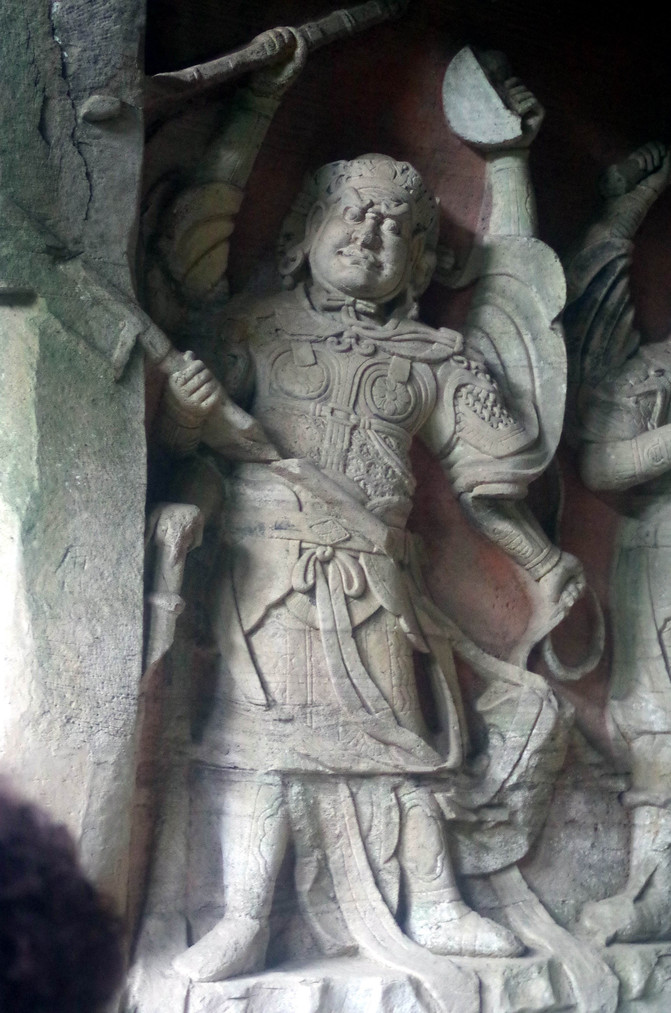

This is a statue of Shuiyue Guanyin. From a sitting position, it resembles the image of a dusty woman, so people call her Shuiyue Guanyin.

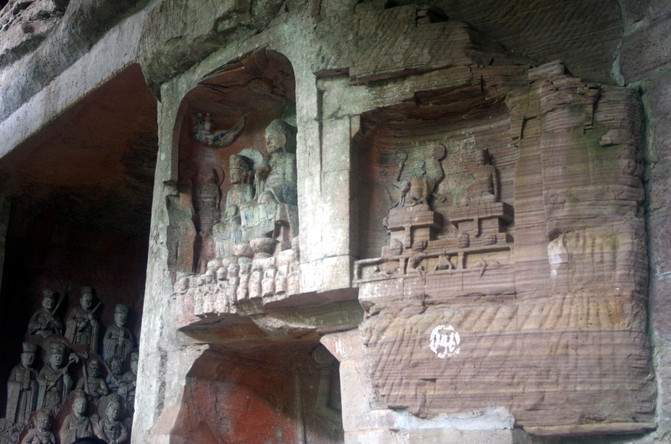
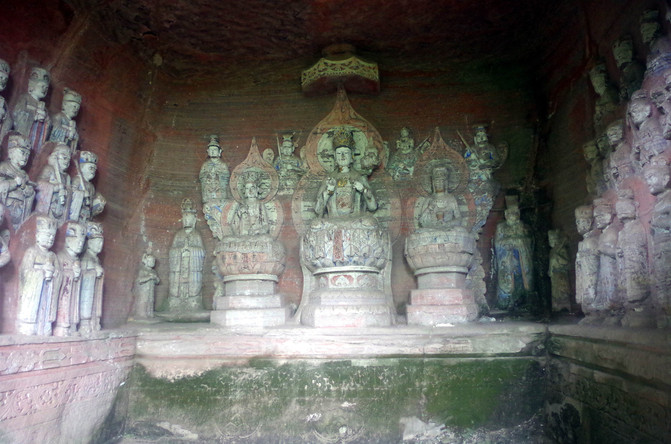




After driving south for more than ten kilometers, we arrived at Baoding Mountain. I had lunch at a restaurant on Baoding Mountain. After finishing our meal, we took a few types of cars and arrived at the location of the grotto.


The newly built stone memorial archway is very solemn.


Compared with the Beishan Grottoes, the stone carvings on Baoding Mountain are more vivid and representative. It is hidden deep in a deep mountain forest, with a horseshoe shaped cliff bend, a total length of over 500 meters, and more than 10000 statues. It was excavated from the Tang and Five Dynasties to the early Song Dynasty, lasting approximately 250 years.

Among the four major grottoes in China, the Datong Grottoes during the Northern Wei Dynasty focused on the essence of Buddhism and had a more religious color, with more vivid and rough character images. The Longmen Grottoes in Luoyang, excavated from the late Northern Wei to the early Tang Dynasty, tend to be more aesthetically pleasing. The typical Lushena Buddha depicts the plump and beautiful characteristics of Tang Dynasty women, and its image is said to resemble that of Empress Wu Zetian. In the mid Tang Dynasty, the Mogao Caves in Dunhuang focused more on expressing the mysterious color of Buddhism. Its character image tends to be more romantic.


The most prominent feature of the Dazu Rock Carvings of the Five Dynasties and the early Song Dynasty in front of us is that they are more secular. There are many distinctive behaviors and costumes of officials and citizens in the characters at that time. Just like the Water Moon Guanyin in the Beishan Stone Carvings, it has developed towards beauty and commodification. Seeing the statue can evoke thoughts of people's psychology and behavior at that time. The statue above looks more like a family, with the person in the middle being an official and surrounded by his family.

Dazu Rock Carvings is the only historic site in Chongqing that has entered the world cultural heritage.
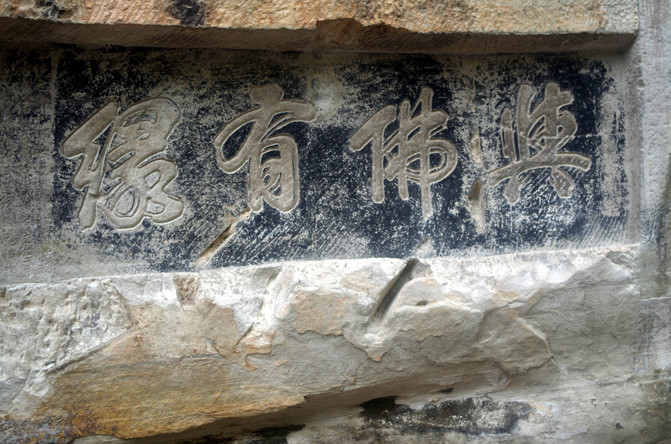
It emphasizes that people should have a connection with Buddha, which has the function of persuading people to do good.

The statue above depicts the hardships of parents raising their children,



The previous statue depicts a scene in hell, in which there is a pot of oil. When a person commits evil and goes to hell, they must put it in the pot and suffer.
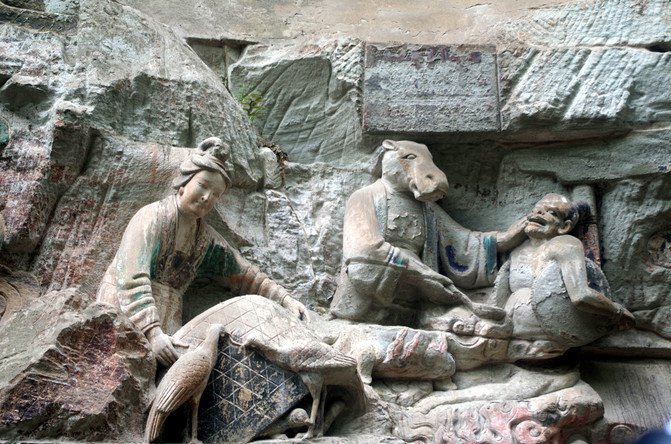
The picture above, on the right, shows a horse's face, depicting a person who often spreads rumors to mislead the public. When they go to hell, their tongue will be pulled out. The woman on the left who feeds the chickens is one of the two beautiful women in the Baoding Mountain stone carvings, depicting her committing an act of chastity in the human world and going to hell. The judge asked her to feed the chickens with millet, and only allowed her to leave hell after eating up a mountain of rice.



This is also a person who committed evil in hell, and after going to hell, his feet were chopped off






This is a scene of a filial son carrying his parents, urging people to be kind and filial

This is the second beauty of Baoding Mountain - the Pied Piper. In beautiful music, even livestock become gentle

The above picture shows two shepherds leisurely sitting and enjoying themselves amidst the sound of a flute playing woman, while the old cow also smiles. Buddhism is like music that brings joy to people.



This is clearly not a Buddha, it is completely the attire of an official.


This is the Great Sleeping Buddha on Baoding Mountain, which is also one of the very few in the country. It is the holy relic of Shakyamuni Buddha's Nirvana, depicting the appearance of the Buddha Shakyamuni Buddha during his Nirvana. Tourists standing are not as tall as the Buddha's side face when lying down.




Kowloon spitting water map.

The Thousand Armed Guanyin statue is said to have been consecrated by Mr. Zhao Puchu, the president of the Buddhist Association of China.

Side photo of Thousand Armed Guanyin.


I seem to have seen these tall statues before in the Maijishan Grottoes



This is the six cycle diagram in Buddhism. The upper three paths are blessings, and the lower three paths are hell.


These pictures are of the Guardian God, It looks very majestic.










The statue above is said to be the local official who organized the excavation of these stone carvings.
In a word, the art of Dazu Rock Carvings has become worldly. It helps people understand the significance of Buddhism and human nature education, and tends towards a secular and straightforward understanding of the true essence of Buddhism.
The following is a picture of the rural and field scenery taken on the way back.







Gradually entering the urban area of Chongqing.

In the next travelogue, I will introduce the unforgettable corners of Chongqing. In this way, my in-depth tour of Chongqing has been perfectly completed. ha-ha.
Previous Article:Chongqing Walking Diary - Internet celebrity Yangtze River Cableway
